-
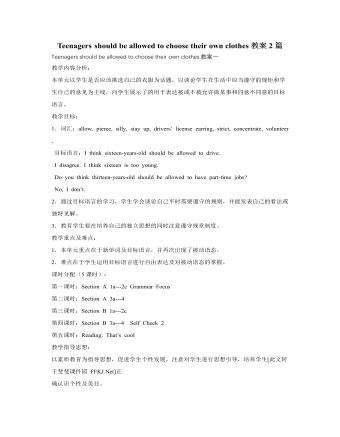
人教版新目标初中英语九年级上册Teenagers should be allowed to choose their own clothes教案2篇
Step 1 Greeting Greet the class and check the homeworkStep 2 A duty report The S on duty gives a report on the rules in his home and lead in 3a “Sun Fei’s and Wu Yu’s rules” Step 3 ReadingSs read the conversation and write the two girls’ rules in the chart. Check the answers.Get Ss to read after the tape and then read aloud by themselves. Then, T explains the language points.Step 4 Pairwork 3bRole play. Use the information in chart to practice with the conversation in 3a covered. They can look at the sample conversation in the right box.Step 5 Task 2 “Who’s the best reporter?”Make a survey by asking any 5 students the questions in the chart in activity 4. Then give out a report about it. See who is the best reporter? And the best reporter will get a nice ball-pen.Step 6 Summary and homework:Write out the report in your exercise-books.Period ThreeStep 1 Greeting and a duty reportThe S gives a duty report talking about his experience of being late for school. Lead in the question “Do you ever get to school late? How often do you get to school late? Always, usually, sometimes, or never?Step 2 1a Get Ss to finish writing.Step 3 Pairwork 1b Get Ss to talk about their answers with their partners using the sample conversation in the box on the right.Step 4 Listening practice2a Lead-in: What will happen if you get to school late? What about Peter? Let’s listen to a conversation between Peter and his father. Get Ss to finish 2a (As usual, for the first time, Ss only listen.) Check the answers.
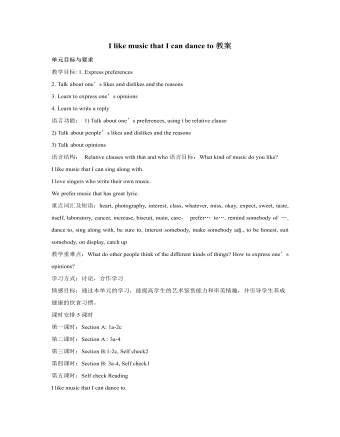
人教版新目标初中英语九年级上册I like music that I can dance to教案
教学目标: 1. Express preferences2. Talk about one’s likes and dislikes and the reasons3. Learn to express one’s opinions 4. Learn to write a reply 语言功能: 1) Talk about one’s preferences, using t he relative clause2) Talk about people’s likes and dislikes and the reasons3) Talk about opinions语言结构: Relative clauses with that and who语言目标:What kind of music do you like?I like music that I can sing along with.I love singers who write their own music.We prefer music that has great lyric.重点词汇及短语:heart, photography, interest, class, whatever, miss, okay, expect, sweet, taste, itself, laboratory, cancer, increase, biscuit, main, care, prefer… to…, remind somebody of …, dance to, sing along with, be sure to, interest somebody, make somebody adj., to be honest, suit somebody, on display, catch up教学重难点:What do other people think of the different kinds of things? How to express one’s opinions? 学习方式:讨论,合作学习情感目标:通过本单元的学习,能提高学生的艺术鉴赏能力和审美情趣,并引导学生养成健康的饮食习惯。课时安排5课时第一课时:Section A: 1a-2c第二课时:Section A : 3a-4第三课时:Section B:1-2c, Self check2第四课时:Section B: 3a-4, Self check1第五课时:Self check ReadingI like music that I can dance to.
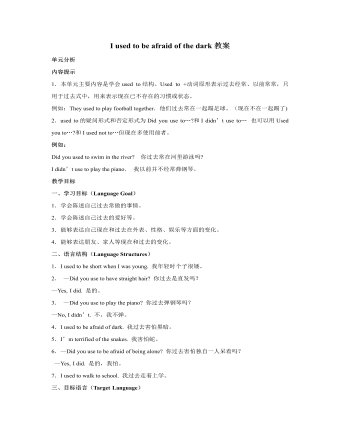
人教版新目标初中英语九年级上册I used to be afraid of the dark教案
内容提示1.本单元主要内容是学会used to结构。Used to +动词原形表示过去经常、以前常常,只用于过去式中,用来表示现在已不存在的习惯或状态。例如:They used to play football together.他们过去常在一起蹋足球。(现在不在一起踢了)2.used to的疑问形式和否定形式为Did you use to…?和I didn’t use to… 也可以用Used you to…?和I used not to…但现在多使用前者。例如:Did you used to swim in the river? 你过去常在河里游泳吗?I didn’t use to play the piano. 我以前并不经常弹钢琴。教学目标一、学习目标(Language Goal) 1.学会陈述自己过去常做的事情。2.学会陈述自己过去的爱好等。3.能够表达自己现在和过去在外表、性格、娱乐等方面的变化。4.能够表达朋友、家人等现在和过去的变化。二、语言结构(Language Structures) 1.I used to be short when I was young. 我年轻时个子很矮。 2. —Did you use to have straight hair? 你过去是直发吗?—Yes, I did. 是的。 3. —Did you use to play the piano? 你过去弹钢琴吗?—No, I didn’t. 不,我不弹。 4.I used to be afraid of dark. 我过去害怕黑暗。 5.I’m terrified of the snakes. 我害怕蛇。

人教版新目标初中英语九年级上册How do you study for a test教案2篇
内容提示本单元主要内容是学会利用verb十by/with gerund表示方式方法来讨论学习英语的策略,认识自己在学习方面的长处和不足。初步了解现在完成时的结构和用法。现在完成时由助动词have/has+动词的过去分词构成,主要表示过去发生的某一动作对现在仍有影响或造成的后果,常与already,yet,just,ever,never等副词连用。教学目标一、学习目标(Language Goal) 1. Talk about how to study . 学会讨论各种学习方法和策略。2. Find out your suitable learning methods. 找出适合自己的学习方法。 二、语言结构(Language Structures) 1. Verb + by with gerund by+动名词短语 表示“通过…途径,方法” 2. How questions have引导的特殊疑问句 三、目标语言(Target Language) 1. How do you study for tests ? 你是怎样准备考试的?Well , I study by working with my classmates. 哦,我和同学们一起学习。2. Have you ever studied with a group ? 你曾经参加过学习小组吗?Yes , I have . I’ve learned a lot that way . 是的,参加过。通过这种方式我学了许多。
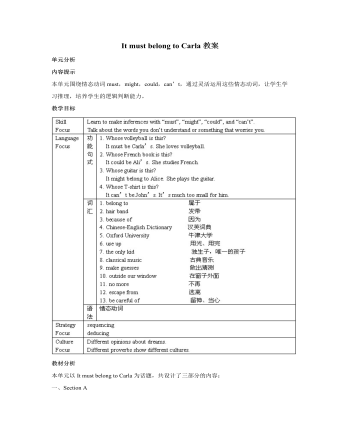
人教版新目标初中英语九年级上册It must belong to Carla教案
一、Section A该部分有4个模块。第一模块围绕Whose volleyball is this? 这一话题展开思维( 1a)、听力(1b)、口语( 1c)训练;第二模块围绕上一模块中的话题进行听力( 2a-2b)、口语训练( 2c);第三模块继续围绕前两个模块中的“making inferences”展开训练。训练形式为阅读排序( 3a)和两人问答(3b);第四模块仍就上一话题展开讨论。二、Section B该部分有4个模块。第一模块要求根据图画和所提供的单词写出合理的句子;第二模块在听力( 2a-2b)和分角色口语训练( 2c)的基础上,继续进行“推测”训练; 第三模块围绕“Strange events in Bell Tower neighborhood”这一话题展开阅读( 3a)和写作(3b -3c)训练;第四模块以dream为话题展开小组活动。三、Self Check该部分有3个模块。第一模块以填空形式对所学词汇进行训练;第二模块就8个谚语展开阅读和讨论。
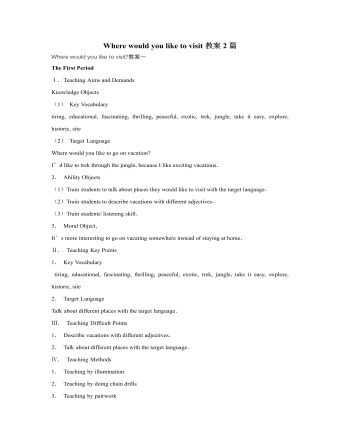
人教版新目标初中英语九年级上册Where would you like to visit教案2篇
The First PeriodⅠ.Teaching Aims and DemandsKnowledge Objects(1) Key Vocabularytiring, educational, fascinating, thrilling, peaceful, exotic, trek, jungle, take it easy, explore, historic, site(2) Target LanguageWhere would you like to go on vacation?I’d like to trek through the jungle, because I like exciting vacations.2. Ability Objects(1)Train students to talk about places they would like to visit with the target language.(2)Train students to describe vacations with different adjectives.(3)Train students' listening skill.3. Moral Object,It′s more interesting to go on vacating somewhere instead of staying at home.Ⅱ. Teaching Key Points1. Key Vocabularytiring, educational, fascinating, thrilling, peaceful, exotic, trek, jungle, take it easy, explore, historic, site2. Target LanguageTalk about different places with the target language.Ⅲ. Teaching Difficult Points1. Describe vacations with different adjectives.2. Talk about different places with the target language.Ⅳ. Teaching Methods1. Teaching by illumination2. Teaching by doing chain drills3. Teaching by pairworkⅤ. Teaching Aids1. A tape recorder2. Some pictures of different places with famous views

人教版新目标初中英语八年级上册Could you please clean your room教案3篇
一、 教学内容Section A 1a----1c二、 教学目标1.学习词汇do the dishes, make the bed, take out the trash, fold the clothes, do the laundry, sweep the floor, clean the living room.2.句型 Could you please clean your room? Yes, sure.三、 教学准备 学生预习本单元所有的词汇多媒体课件 活动表 奖品四、 教学过程Pre-task1. Warming upEnjoy ourselves. Watch cartoon Cinderella. 看动画片段《灰姑娘》导如入本课话题和新词汇“chores”美丽善良的鬼姑娘因继母的嫉妒,每天得做所有的家务。片段的主题使学生联想到本课的话题。2. learn new words and phrasesLook! What is she / he dong? 看图学习动词词组do chores, do the dishes, make the bed, take out the trash, fold the clothes, do the laundry, clean the living room.3. Guessing game.What is she doing ? 4. Pair work. 1a, Do you do these things at home? Write “Y” for “yes” and “N” for “no”.5. Listening . 1b , Peter’s chores or Mom’s chores?理解目标语Could you please clean your room? Yes, sure.Write “M” for Mom’s chores, “P” for Peter’s chores in the chart.6. PairworkLook at the picture,Ask your partner to do the chores that you see. 7. Interview Who is the most able at home? 1) What chores do you do at home? How often do you do the chores? Work in four, interview each of the students in the group, fill in the chart.
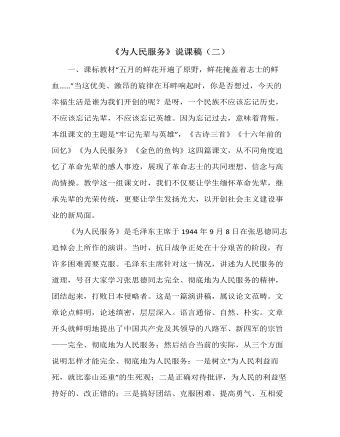
部编人教版六年级下册《为人民服务》说课稿(二)
二、教法学法(一)突出主体,选择教法:课堂是学习的场所,学生是学习的主人。《语文课程标准》明确指出:“积极倡导自主、合作、探究的学习方式”,要充分发挥学生的主体作用,全面提高学生的语文素养。基于以上的认识,我选择教法如下:1.以读为主,读思写结合法;2.引扶放相结合,意在引导学生注意议论文的特点与学习方法,从而培养学生自能读书的能力与习惯。(二)重在实践,指导学法:“语文是实践性很强的课程”,就是要让学生在大量的语文实践中掌握运用语文的规律与方法,也就是既要“授人以鱼”,更要“授人以渔。为此,我指导学生以读为本,体会文章论述方法、抓住重点词句进行理解课文。三、教学过程:(一)回忆旧知,导入新课1.上节课我们通过学习课文,你还记得课文中心论点是什么吗?哪个句子点明了这个观点?(指名答,板书:全心全意为人民服务)2.课文从哪些方面对这个观点展开叙述?(指名答,板书:死的意义、正确对待批评、团结人民)
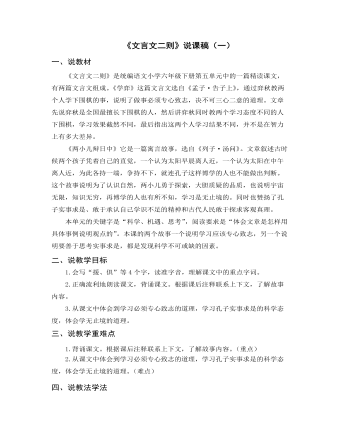
部编人教版六年级下册《文言文二则》说课稿(一)
一、说教材《文言文二则》是统编语文小学六年级下册第五单元中的一篇精读课文,有两篇文言文组成。《学弈》这篇文言文选自《孟子·告子上》,通过弈秋教两个人学下围棋的事,说明了做事必须专心致志,决不可三心二意的道理。文章先说弈秋是全国最擅长下围棋的人,然后讲弈秋同时教两个学习态度不同的人下围棋,学习效果截然不同,最后指出这两个人学习结果不同,并不是在智力上有多大差异。《两小儿辩日中》它是一篇寓言故事,选自《列子·汤问》。文章叙述古时候两个孩子凭着自己的直觉,一个认为太阳早晨离人近,一个认为太阳在中午离人近,为此各持一端,争持不下,就连孔子这样博学的人也不能做出判断。这个故事说明为了认识自然,两小儿勇于探索,大胆质疑的品质,也说明宇宙无限,知识无穷,再博学的人也有所不知,学习是无止境的。同时也赞扬了孔子实事求是、敢于承认自己学识不足的精神和古代人民敢于探求客观真理。
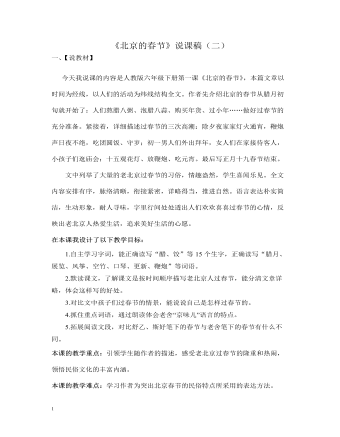
部编人教版六年级下册《北京的春节》说课稿(二)
一、【说教材】今天我说课的内容是人教版六年级下册第一课《北京的春节》,本篇文章以时间为经线,以人们的活动为纬线结构全文。作者先介绍北京的春节从腊月初旬就开始了:人们熬腊八粥、泡腊八蒜、购买年货、过小年……做好过春节的充分准备。紧接着,详细描述过春节的三次高潮:除夕夜家家灯火通宵,鞭炮声日夜不绝,吃团圆饭、守岁;初一男人们外出拜年,女人们在家接待客人,小孩子们逛庙会;十五观花灯、放鞭炮、吃元宵。最后写正月十九春节结束。文中列举了大量的老北京过春节的习俗,情趣盎然,学生喜闻乐见。全文内容安排有序,脉络清晰,衔接紧密,详略得当,推进自然。语言表达朴实简洁,生动形象,耐人寻味,字里行间处处透出人们欢欢喜喜过春节的心情,反映出老北京人热爱生活,追求美好生活的心愿。
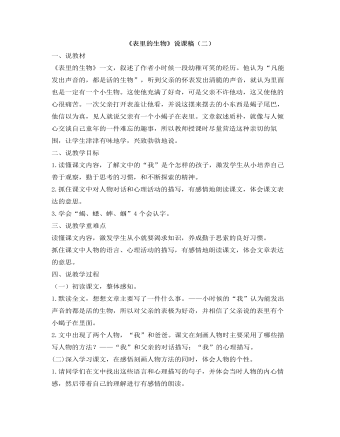
部编人教版六年级下册《表里的生物》说课稿(二)
一、说教材《表里的生物》一文,叙述了作者小时候一段幼稚可笑的经历。他认为“凡能发出声音的,都是活的生物”,听到父亲的怀表发出清脆的声音,就认为里面也是一定有一个小生物。这使他充满了好奇,可是父亲不许他动,这又使他的心很痛苦。一次父亲打开表盖让他看,并说这摆来摆去的小东西是蝎子尾巴,他信以为真,见人就说父亲有一个小蝎子在表里。文章叙述质朴,就像与人倾心交谈自己童年的一件难忘的趣事,所以教师授课时尽量营造这种亲切的氛围,让学生津津有味地学,兴致勃勃地说。二、说教学目标1.读懂课文内容,了解文中的“我”是个怎样的孩子,激发学生从小培养自己善于观察,勤于思考的习惯,和不断探索的精神。2.抓住课文中对人物对话和心理活动的描写,有感情地朗读课文,体会课文表达的意思。
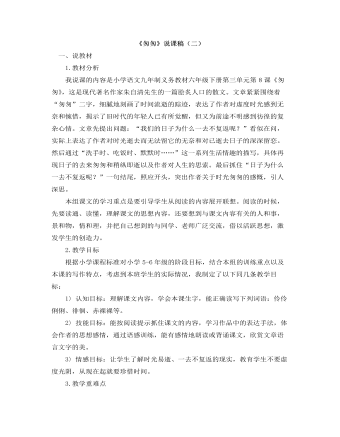
部编人教版六年级下册《匆匆》说课稿(二)
一、说教材1.教材分析我说课的内容是小学语文九年制义务教材六年级下册第三单元第8课《匆匆》,这是现代著名作家朱自清先生的一篇脍炙人口的散文。文章紧紧围绕着“匆匆”二字,细腻地刻画了时间流逝的踪迹,表达了作者对虚度时光感到无奈和惋惜,揭示了旧时代的年轻人已有所觉醒,但又为前途不明感到彷徨的复杂心情。文章先提出问题:“我们的日子为什么一去不复返呢?”看似在问,实际上表达了作者对时光逝去而无法留它的无奈和对已逝去日子的深深留恋。然后通过“洗手时、吃饭时、默默时……”这一系列生活情趣的描写,具体再现日子的去来匆匆和稍纵即逝以及作者对人生的思索。最后抓住“日子为什么一去不复返呢?”一句结尾,照应开头,突出作者关于时光匆匆的感慨,引人深思。
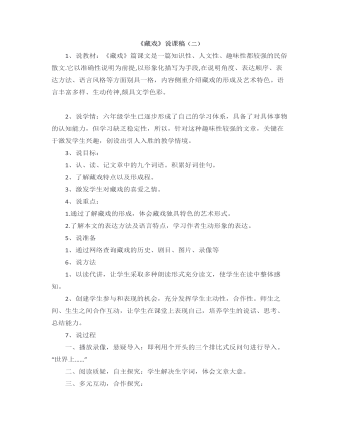
部编人教版六年级下册《藏戏》说课稿(二)
1、说教材:《藏戏》篇课文是一篇知识性、人文性、趣味性都较强的民俗散文.它以准确性说明为前提,以形象化描写为手段,在说明角度、表达顺序、表达方法、语言风格等方面别具一格,内容侧重介绍藏戏的形成及艺术特色。语言丰富多样、生动传神,颇具文学色彩。2、说学情:六年级学生已逐步形成了自己的学习体系,具备了对具体事物的认知能力,但学习缺乏稳定性,所以,针对这种趣味性较强的文章,关键在于激发学生兴趣,创设出引人入胜的教学情境。3、说目标:1、认、读、记文章中的九个词语。积累好词佳句。2、了解藏戏特点以及形成程。3、激发学生对藏戏的喜爱之情。4、说重点:1.通过了解藏戏的形成,体会藏戏独具特色的艺术形式。2.了解本文的表达方法及语言特点,学习作者生动形象的表达。5、说准备1、通过网络查询藏戏的历史、剧目、图片、录像等
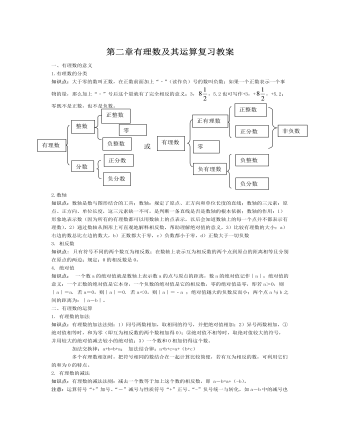
北师大初中七年级数学上册第二章复习教案
. 一个数的倒数等于它本身的数是()A.1 B. C.±1 D.04. 下列判断错误的是()A.任何数的绝对值一定是非负数; B.一个负数的绝对值一定是正数;C.一个正数的绝对值一定是正数; D.一个数不是正数就是负数;5. 有理数a、b、c在数轴上的位置如图所示则下列结论正确的是()A.a>b>0>c B.b>0>a>cC.b<a<0< D.a<b<c<06.两个有理数的和是正数,积是负数,则这两个有理数( )A.都是正数; B.都是负数; C.一正一负,且正数的绝对值较大; D.一正一负,且负数的绝对值较大。7.若│a│=8,│b│=5,且a + b>0,那么a-b的值是( )A.3或13 B.13或-13 C.3或-3 D.-3或-138. 大于-1999而小于2000的所有整数的和是()A.-1999 B.-1998 C.1999 D.20009. 当n为正整数时, 的值是()
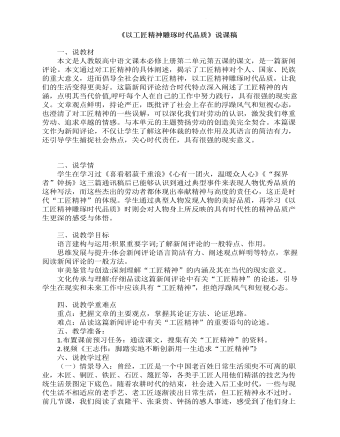
《以工匠精神雕琢时代品质》说课稿 2022-2023学年统编版高中语文必修上册
答案:铜车马的辉煌,来自原料的精挑细选、工艺的精巧极致和工匠的精心雕琢。可以说,是精益求精的工匠精神锻造出了“青铜之冠”的铜车马。2.“工匠精神”如此重要,那么,你认为“工匠精神”有着怎样的现实意义?观点一:工匠精神在企业层面,可以认为是企业精神。具体而言,表现在以下几个方面。第一,创新是企业不断发展的精神内核。第二,敬业是企业领导者精神的动力。第三,执着是企业走得长久的底气。改革开放40 多年来,我国涌现出大批有工匠精神的企业,但也有一些企业缺乏企业精神,只追求“短平快”的经济效益。这正是经济发展的隐忧所在。观点二:工匠精神在员工层面,就是一-种认真精神、敬业精神。其核心是: 不仅仅把工作当作赚钱养家糊口的工具,而是树立起对职业敬畏、对工作执着、对产品负责的态度,极度注重细节,不断追求完美和极致,给客户无可挑剔的体验。我国制造业存在大而不强、产品档次整体不高、自主创新能力较弱等现象,多少与工匠精神稀缺、“差不多精神”有关。
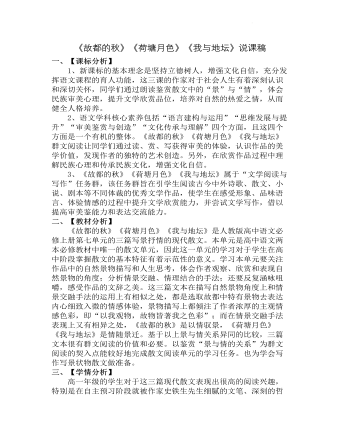
《故都的秋》《荷塘月色》《我与地坛》群文阅读说课稿 2022-2023学年统编版高中语文必修上册
(2) 中国文人的悲秋情结。3.《荷塘月色》中,作者为什么要离开家来到荷塘散步?4. 思考:作者的心里为何“颇不宁静?”(教师补充:写作背景)5. 出门散步后,作者的心情发生变化了吗? 有怎样的变化?6.思考讨论:为什么作者说“我”与“地坛”间有着宿命般的缘分,二者有何相似之处?(阅读1-5段)7.思考:作者从他同病相怜的“朋友“身上理解了怎样的”意图“?三、课堂总结李白说:“天地者,万物之逆旅也。”人生,如同一场旅行,在人生的旅途中,时而高山,时而峡谷,时而坦途,时而歧路。我们或放歌,或悲哭,然而,大自然始终以其不变的姿势深情地看着我们,而我们,也应该学会在与自然的深情对望中,找到生命的契合。正如敬亭山之于李白,故都的秋之于郁达夫,荷塘月色之于朱自清,地坛之于史铁生,他们从中或得到心灵的慰藉、精神的寄托,或得到生存的智慧与勇气,最终完成精神的超脱。
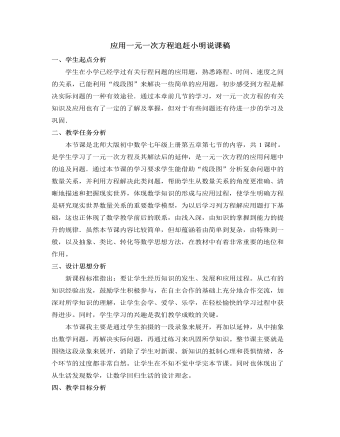
北师大初中数学七年级上册应用一元一次方程追赶小明说课稿
目的:进一步理解追击问题的实质,与课程引入中的灰太狼追喜羊羊故事呼应,问题得到解决。环节三、运用巩固活动内容:育红学校七年级学生步行郊外旅行,1班的学生组成前队,步行速度为4千米/小时,3班的学生组成后队,步行速度为6千米/小时,1班出发一个小时后,3班才出发。请根据以上的事实提出问题并尝试回答。问题1:3班追上1班用了多长时间 ?问题2:3班追上1班时,他们离学校多远?问题3:………………目的:给学生提供进一步巩固建立方程模型的基本过程和方法的熟悉机会,让学生活学活用,真正让学生学会借线段图分析行程问题的方法,得出其中的等量关系,从而正确地建立方程求解问题,同时还需注意检验方程解的合理性.实际活动效果:由于题目较简单,所以学生分析解答时很有信心,且正确率也比较高,同时也进一步体会到了借助“线段图”分析行程问题的优越性.
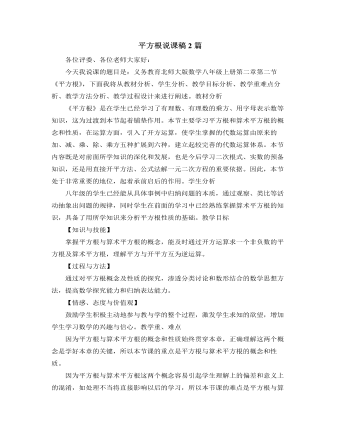
北师大版初中八年级数学上册平方根说课稿2篇
让学生先独立解决⑴题,再小组交流⑵题的答案,找到解题的方法.2、例2,例3是对平方根概念的巩固与拓展,在例2中由于学生还不熟于平方根的表示方法,所以应在平方根的概念和±号上加以明确,而例3则要把握平方根概念的本质,根据该数的正负或0来确定其平方根,这部分内容可用板演或展台展示结果的方式进行,让学生独立完成,应给予恰当的评价.3、最后,我又设计了一道辨析题:在做一道求4的平方根的题目时,小明说:“4的平方根是2”,小红说:“4的平方根是-2”,小强说:“2是4的平方根”小芳说:“-2是4的平方根”,请问他们的说法正确吗?通过这道题目,使学生在熟悉平方根概念的基础上更加深理解,同时对以往五种运算中从未出现过的一题两解的现象作出了解释,使学生明白了一种整体与局部的关系,再一次突出了重点.

北师大版初中八年级数学上册三角形内角和定理说课稿2篇
三、说教法和学法:1、说教法:本节课采用几何画板与电子白板相结合的教学手段,使操作过程形象、直观呈现,以便学生更好的理解。在教学过程中,引导学生去探索,使学生感受到添加辅助线的数学思想,更好地掌握三角形内角和定理的证明及简单的应用,2、说学法:根据本节课特点和学生的实际,在教学过程中给学生足够的时间认真、仔细地动手书写证明过程,使学生的学习落到实处。同时,培养学生科学的学习方法和自信心。四、说教学过程设计教学过程的设计有:1、问题引入新课:七年级已经学习三角形内角和定理内容。这样从已经学过的知识引入,符合学生的认知规律。在拼图活动中发展思维的灵活性、创造性,为下一环节“说理”证明作好准备,使学生体会到数学来源于实践,同时对新知识的学习有了期待。
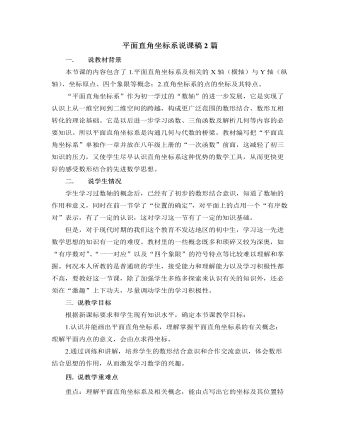
北师大版初中八年级数学上册平面直角坐标系说课稿2篇
【设计意图】:这一环节的设计主要是为了培养学生自主学习的能力,让学生在自学中初步认识概念。通过材料的阅读,活动的实践,让学生在自画、自纠中,加深对概念的理解,培养学生良好的画图习惯。(三)例题讲解学生活动4:(由于例题都比较简单,所以让学生自己先做,教师巡视指导)例1、写出图中A、B、C、D、E各点的坐标。例2、在直角坐标系中,描出下列各点:A(4,3), B(-2,3),C(-4,-1),D(2,-2)。【设计意图】:例1的目的是给出点的位置,写出点的坐标。例2的目的是给出点的坐标,描出点。学完概念之后,马上对概念进行应用,达到巩固的目的。当时上课时这2道例题的解答都比较圆满,绝大部分学生都能顺利做出。